A team of two UNLV biologists has received a $235,000 research and teaching grant from The Andrew W. Mellon Foundation to study the structure and function of ecosystems in the Mojave Desert.
UNLV biology professors Stan Smith and Diane Wagner will work with UNR professors Robert Nowak and Robert Qualls on the project. A number of graduate and undergraduate students also will be involved in the research.
"We will be looking at how the very limited amounts of water and nutrients available to the ecosystem affect the overall system. Key to our research will be to determine the importance of microbiotic crusts -- a layer on the soil surface formed by plant matter such as algae and lichens -- in the water and nutrient cycles of desert ecosystems," Smith said.
"We know that that type of surface is extremely susceptible to disturbance by a variety of land-use practices, such as livestock grazing and off-road vehicle use, yet there are few studies that have experimentally assessed the role of these crusts in overall ecosystem function," he said. "In addition, none of the studies that have been done thus far have been done in as arid a region as the Mojave Desert."
The study will be conducted at the Long Term Desert Ecological Research Site, which was built on the Nevada Test Site with funds from the National Science Foundation-funded EPSCoR program and the Nevada Operations Office of the U.S. Department of Energy.
Smith said one of the reasons the Test Site land is an excellent location for the experiments to be conducted is because it has been free from grazing for the past 50 years and, as a result, provides a relatively pristine desert landscape.
Among the experiments to be conducted are removing the surface crusts by mechanical scraping, adding nitrogen to the surface to counteract the loss of the crust, and adding water to simulate increased summer rainfall.
"We're eager to learn what impact land-use practices that tend to destroy desert crust surfaces will have on the function of desert ecosystems. In the past, we have had to assess this by studying sites that were already disturbed, but this will be the first such study where we can assess ecosystem response as the disturbances occur, and in so doing, better understand the relative importance of these crusts in deserts," Smith said.
For additional information on the grant and the research, call Smith at 895-3197 or Wagner at 895-4421.
UNLV is a doctoral-degree granting institution with some 22,000 students and more than 700 faculty members. Nearly 170 undergraduate, master's, and doctoral degrees are offered. Founded in 1957, UNLV is located on 335 acres in dynamic Southern Nevada. The university has been ranked in the category of Doctoral/Research Universities -- Intensive by the Carnegie Foundation for the Advancement of Teaching.



